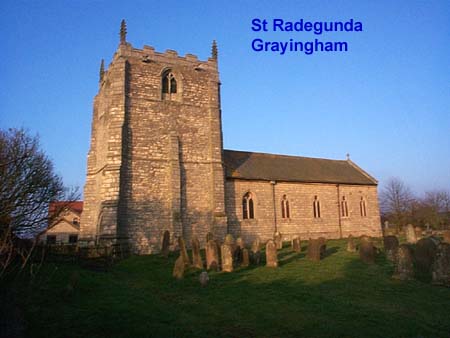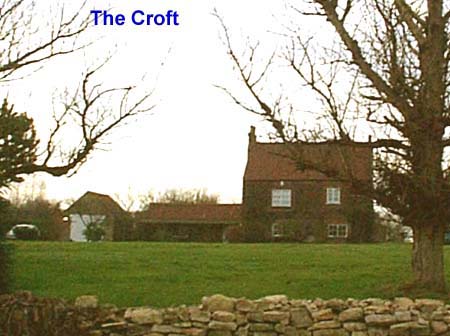 Click to return to Home Page
Click to return to Home Page| Early History | St.Radegunda's Church | The Croft |
The following are some variations of the spelling as found in medieval documents:
In later times the name has usually been spelled Grayingham or Graingham, both probably trisyllabic.
Entries in the Domesday Book regarding Grayingham refer to lands of the King
in the Manor of Chirchetone (i.e. Kirton) - 4 'carucates';
of the Bishop of Lincoln - 1 'carucate'; and of Ernest de Burun - 1 'carucate',
(a 'carucate' was an area of land).
This shows that most of the Parish was royal property, attached to the important
Manor of Kirton.
 The tiny church, with it's massive tower, dates back to the
12th century. There has been a church on the site since Saxon times,
but it was rebuilt in 1797 with further alterations at the beginning
of the 20th century. It can seat 90 people.
The tiny church, with it's massive tower, dates back to the
12th century. There has been a church on the site since Saxon times,
but it was rebuilt in 1797 with further alterations at the beginning
of the 20th century. It can seat 90 people.
The origin of the church's unusual name dates from the foundation
of the Trinitarians, the Order of the most Holy Trinity for the
redemption of captives. This order was formed by St. John de Matha,
who was born in Faucon provence in France in 1154, and Felix de Valois.
They apparently travelled to Rome to obtain the approbation of the Pope,
Innocent III, for ratification of the order. They placed themselves under the
protection of St. Radegunda, the daughter of Berthaire, king of the Thuringians.
Berthaire was killed by his brother, Hermannfried, who took Radegunda and
educated her, but was himself slain by the Frankish kings Theuderich and
Clotaire in 564. Clotaire took Radegunda captive and later married her.
The legend surrounding her life tells of her hearing the voices of prisoners
weeping in their fetters and imploring pity. Remembering her early sorrows,
she wept and, not knowing how to help them, she began to pray. The prisoners'
fetters were miraculously broken and they were freed from captivity.
Afterwards Radegunda became a nun and founded a convent at Poitiers,
where she lived in sanctity ministering to the poor. She died on the
13th August, 587.
 Standing in it's large grounds opposite Church Lane is The Croft,a charming cottage
which was once the village Post Office (there isn't one now).
Standing in it's large grounds opposite Church Lane is The Croft,a charming cottage
which was once the village Post Office (there isn't one now).